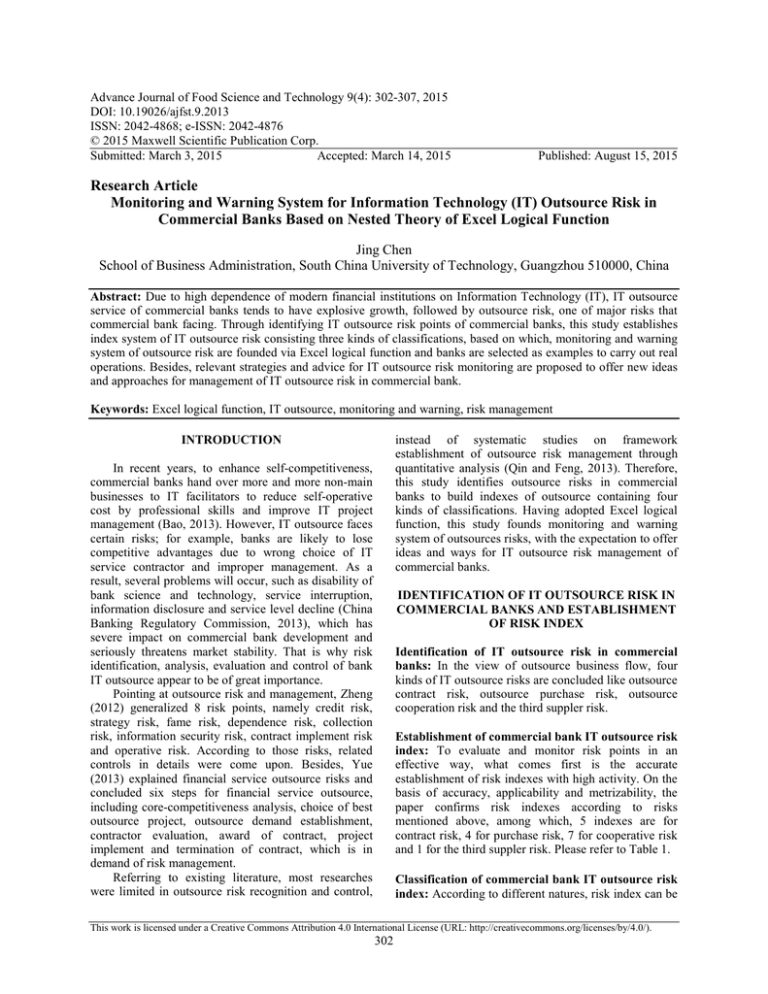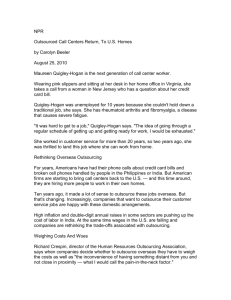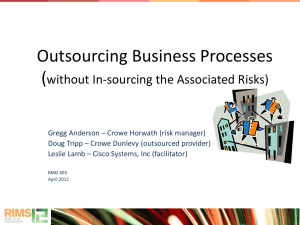Advance Journal of Food Science and Technology 9(4): 302-307, 2015
advertisement

Advance Journal of Food Science and Technology 9(4): 302-307, 2015 DOI: 10.19026/ajfst.9.2013 ISSN: 2042-4868; e-ISSN: 2042-4876 © 2015 Maxwell Scientific Publication Corp. Submitted: March 3, 2015 Accepted: March 14, 2015 Published: August 15, 2015 Research Article Monitoring and Warning System for Information Technology (IT) Outsource Risk in Commercial Banks Based on Nested Theory of Excel Logical Function Jing Chen School of Business Administration, South China University of Technology, Guangzhou 510000, China Abstract: Due to high dependence of modern financial institutions on Information Technology (IT), IT outsource service of commercial banks tends to have explosive growth, followed by outsource risk, one of major risks that commercial bank facing. Through identifying IT outsource risk points of commercial banks, this study establishes index system of IT outsource risk consisting three kinds of classifications, based on which, monitoring and warning system of outsource risk are founded via Excel logical function and banks are selected as examples to carry out real operations. Besides, relevant strategies and advice for IT outsource risk monitoring are proposed to offer new ideas and approaches for management of IT outsource risk in commercial bank. Keywords: Excel logical function, IT outsource, monitoring and warning, risk management instead of systematic studies on framework establishment of outsource risk management through quantitative analysis (Qin and Feng, 2013). Therefore, this study identifies outsource risks in commercial banks to build indexes of outsource containing four kinds of classifications. Having adopted Excel logical function, this study founds monitoring and warning system of outsources risks, with the expectation to offer ideas and ways for IT outsource risk management of commercial banks. INTRODUCTION In recent years, to enhance self-competitiveness, commercial banks hand over more and more non-main businesses to IT facilitators to reduce self-operative cost by professional skills and improve IT project management (Bao, 2013). However, IT outsource faces certain risks; for example, banks are likely to lose competitive advantages due to wrong choice of IT service contractor and improper management. As a result, several problems will occur, such as disability of bank science and technology, service interruption, information disclosure and service level decline (China Banking Regulatory Commission, 2013), which has severe impact on commercial bank development and seriously threatens market stability. That is why risk identification, analysis, evaluation and control of bank IT outsource appear to be of great importance. Pointing at outsource risk and management, Zheng (2012) generalized 8 risk points, namely credit risk, strategy risk, fame risk, dependence risk, collection risk, information security risk, contract implement risk and operative risk. According to those risks, related controls in details were come upon. Besides, Yue (2013) explained financial service outsource risks and concluded six steps for financial service outsource, including core-competitiveness analysis, choice of best outsource project, outsource demand establishment, contractor evaluation, award of contract, project implement and termination of contract, which is in demand of risk management. Referring to existing literature, most researches were limited in outsource risk recognition and control, IDENTIFICATION OF IT OUTSOURCE RISK IN COMMERCIAL BANKS AND ESTABLISHMENT OF RISK INDEX Identification of IT outsource risk in commercial banks: In the view of outsource business flow, four kinds of IT outsource risks are concluded like outsource contract risk, outsource purchase risk, outsource cooperation risk and the third suppler risk. Establishment of commercial bank IT outsource risk index: To evaluate and monitor risk points in an effective way, what comes first is the accurate establishment of risk indexes with high activity. On the basis of accuracy, applicability and metrizability, the paper confirms risk indexes according to risks mentioned above, among which, 5 indexes are for contract risk, 4 for purchase risk, 7 for cooperative risk and 1 for the third suppler risk. Please refer to Table 1. Classification of commercial bank IT outsource risk index: According to different natures, risk index can be This work is licensed under a Creative Commons Attribution 4.0 International License (URL: http://creativecommons.org/licenses/by/4.0/). 302 Adv. J. Food Sci. Technol., 9(4): 302-307, 2015 Table 1: Dynamic monitoring and warning of commercial bank IT outsource risk indexes Level-one index IT outsource management Level-two index Risk of outsource contract Risk of outsource purchase Risk of outsource cooperation Risk of third suppler Overall outsource risk Level-one index IT outsource management Type-II Yes or no Yes or no Yes or no Value Value Yes or no Value Value Level-three qualitative index IT outsource contract is not passed through IT risk management department. Operative risks related to outsource monitored and controlled by bank are not confirmed in outsource contract. Security responsibility of and requirement for outsource companies are not confirmed in outsource contracts. Contract variance of outsource companies is not fully considered. Vital information is let out and distorted without secrecy agreement from outsource staffs. Outsource does not match institution structure, report line, business strategy and overall risk control of commercial bank. Evaluation of key IT outsource risks does not carried out regularly with report of outsource activities. Detailed evaluation on financial stability and technological experience of outsource companies does not complemented. Risk of the same outsources company for several banks are not taken into consideration. Outsource services do not reach expected level. Outsource contract cannot be carried on because of great financial and staff loss of outsource companies. Intellectual property disputes occur to both sides. Important information is obtained by outsource staffs who are not effectively monitored and controlled. Information got by outsources staffs for work demand is not destroyed after the end of contract. Backdoor and malicious software created by outsource staffs during software development are not detected. IT service outsource emergence is not effectively prevented and controlled without contingency plan. Outsource facilitators are unable to ensure outsource service-related measurements once the third suppler comes across problems. Level-three quantitative index Statics Dynamics Statics Dynamics Weight (%) 5.110 5.110 4.070 4.070 Type-I Management defect Management defect Statics Dynamics 7.330 7.330 Management defect Statics Dynamics Statics Dynamics 3.080 3.080 7.330 7.330 Management defect Management defect Statics Dynamics 7.020 7.020 Management defect Statics Dynamics 7.020 7.020 Management defect Statics Dynamics 7.020 7.020 Management defect Statics Dynamics Statics Dynamics Statics Dynamics 5.850 5.850 2.380 2.380 3.950 3.955 Management defect Management defect Management defect Statics Dynamics Statics Dynamics 1.110 1.110 4.830 4.830 Management defect Human factor Statics Dynamics 5.760 5.760 Human factor Statics Dynamics 5.760 5.760 Human factor Statics Dynamics 3.130 3.130 Management defect Real value (Yuan) 1 Statics 19.230 Dynamics 19.230 Statics Dynamics Acceptance value (Yuan) 1 1 1 1 1 1 30000 50000 0 0 1 1 1 3 20000 20000 1 1 1 1 1 100000 100000 100000 100000 1 1 1 4 100000 100000 303 Management defect Warning No No No Slight No No No Moderate Slight Adv. J. Food Sci. Technol., 9(4): 302-307, 2015 Table 1: Continue Level-one index Type-II Value Value Value Yes or no Value Value Value Yes or no Value Overall outsource risk Real value (Yuan) 0 0 0 0 0 0 0 0 0 0 100% 100% 0 0 1 1 0 0 Normalization processing: 0.37 Normalization processing: 0.41 Acceptance value (Yuan) 100000 100000 100000 100000 100000 100000 0 0 100000 100000 100% 100% 100000 100000 1 1 100000 100000 Normalization processing: 1 Normalization processing: 1 Warning No No No No No No No No No No No classified with multi-angle, helping monitor outsource risks in a comprehensive and accurate way. As in study, risk index is typed from three aspects. warning system of IT outsource risk, which can warn commercial banks before risk occurrence to take relevant measurements. Qualitative index and quantitative index: In Table 1, qualitative index has visual statement of risk behavior characteristics, while quantitative index is able to present risk levels under abnormal circumstance by exact values, whose combination is supposed to comprehensively and accurately confirm risk points. Constitution of monitoring and warning system for IT outsource risks in commercial bank: Warning system in the study is basically divided into four steps, i.e., construction of risk index system, confirmation of risk warning level, dynamic data processing and warning outcome processing, which is presented in Fig. 1. “If-type” index and “value-type” index: To measure and control 17 risk points involved in commercial bank IT outsource, accurate quantization and monitoring are necessary. For one thing, once indexes are divided into “occurrence” and “non-occurrence”, they are named “if-type” indexes which are valued “1” for “yes” and “0” for “no”. For another thing, when an index stays with “occurrence”, its order of severity influences risk degree, which is regarded as “value-type” index. Based on a algorithm, the index is turned into number values between 0 and 1. Operating mechanism of monitoring and warning system for IT outsource risks in commercial bank: If the monitoring and warning system for IT outsources risks wants to operate with high activity, three conditions need to be guaranteed firstly, namely reasonable risk index, accurate index threshold and reasonable risk level (Wang, 2013). In Table 2, according to different index values, risks in this study include no warning, slight warning, moderate warning, serious warning, extremely serious warning and super serious warning. Static index and dynamic index: Static index and dynamic index are determined by the monitoring cycle, among which the former, its cycle lasts for a month when abnormal changes of a quantitative index value are observed and with a one-year cycle, the later records index changes, which is the basis to judge risk occurrence probability. Application of monitoring and warning system for IT outsource risks in commercial bank: After selecting several commercial banks as examples, this study puts the monitoring and warning system into practice to test its operability and practicability. To begin with, skilled personnel from case commercial banks process real values of level-three static indexes and acceptance values of dynamic indexes. Secondly, based on proportion with acceptance values, real values adopt normalization processing to make the results limit between 0 and 1 and ensure warning areas for all indexes. Thirdly, monitoring and DETECTION AND WARNING OF IT OUTSOURCE RISK IN COMMERCIAL BANK If risk identification and risk index system are decided, it is able to further build monitoring and 304 Adv. J. Food Sci. Technol., 9(4): 302-307, 2015 Fig. 1: Monitoring and warning system of IT outsource risk in commercial bank Table 2: Warning criteria of value index Warning level Loss value Super serious warning More than 100% or a million (RMB) overall outsource capital Extremely serious warning 50-100% or half million to a million (RMB) overall outsource capital Serious warning 30-50% or three-hundred thousand to half million (RMB) overall outsource capital Moderate warning 10-30% or one-hundred thousand to three-hundred thousand (RMB) overall outsource capital Slight warning 0-10% or zero to one-hundred thousand (RMB) overall outsource capital No 0 Table 3: Warning criteria of “if-type” index Occurrence Warning level Yes (no) No warning No (yes) Moderate warning in general (according to real situations) Table 4: Warning level of IT outsource risk Warning level Super serious warning Extremely serious warning Serious warning Moderate warning Slight warning No warning Risks More than 100% of acceptance value More than 50-100% of acceptance value More than 30-50% of acceptance value More than 10-30% of acceptance value More than 0-10% of acceptance value Less than acceptance value Risk description High risk Higher risk Moderate risk Lower risk Low risk No Excel logical order = IF (Y = 0, serious warning, no warning) Risk description Super high risk High risk Higher risk Moderate risk Low risk Without risk, basically warning area and the whole warning area give the warning signs and present relevant levels, while the dynamic changes are realized by Excel logical function: warning are carried out from two aspects. On one hand, warning areas indicate warning levels once single indexes monitored exceed security top-limit and suggest standard measurements to control risks, which are performed in Table 2 and 3. On the other hand, the whole index system is monitored to have weighed sum of real values and acceptance values, respectively. Besides, acceptance values are divided into six warning levels which are related to weighted sum of real values, based on which, risk management is implemented. Please refer to Table 4. The two aspects operate simultaneously; if an index is detected abnormal, single • 305 Warning level is divided with different standards when single indexes are monitored. As for “if-type” indexes, its warning criteria and logical orders operate as follows. For instance, if operative risks related to outsource monitored and controlled by bank are confirmed in outsource contract (Table 1), the occurrence value will be “1” meaning “yes” and the warning area Adv. J. Food Sci. Technol., 9(4): 302-307, 2015 Table 5: Array and weight calculation of primary IT risk point in commercial bank 1 2 3 4 5 6 7 8 9 1 1 7/6 7/5 7/5 7/9 7/6 7/8 7/8 7/8 2 6/7 1 6/7 6/5 2/3 1 3/4 3/4 3/4 3 5/7 5/6 1 1 5/9 5/6 5/8 5/8 5/8 4 7/9 5/6 1 19/5 5/9 5/6 5/8 5/8 5/8 5 6/7 3/2 9/5 6/5 1 9/5 9/8 9/8 9/8 6 8/7 1 6/5 8/5 5/9 1 1/3 1/2 1/5 7 8/7 4/3 8/5 8/5 8/9 4/3 1 1 1 8 8/7 4/3 8/5 8/5 8/9 4/3 1 1 1 9 8/7 4/3 8/5 8/5 8/9 4/3 1 1 1 10 8/7 4/3 8/5 8/5 8/9 4/3 1 1 1 • automatically shows “no warning”. Otherwise, the value refers to “0” meaning “no” and “serious warning” shows up (specific level is affected by index risks). When it comes to “value-type” indexes, their major task is loss measurement, whose warning criteria refers to overall capital as presented in Table 3. The following is the logical order. Take “increased cost without the consideration of outsource contract variance” (Table 1) as the example; presuming that overall capital for latest outsource project is 1.2 million (RMB), Excel function makes the warning area present “slight warning” once occurrence value reaches 30 thousand (RMB). But if the occurrence value is 0, “no warning” will be the hint. Speaking from real operation of bank outsource, “increased cost without the consideration of outsource contract variance” are found to have static and dynamic index loss belonging to slight warning, so do “extra cost and loss caused by financial situations and technology defects of outsource companies”. In addition, dynamic indexes for “evaluation frequency of IT outsource risks in the implement of outsource contract” do not get 4 (the standard value), which means “moderate warning”. Besides that, rest indexes are found to be “no warning”. This tells that outsource contract, financial and technological situations of contractor and timely evaluation of risks should be paid attention to because potential risks are detected in IT outsource of commercial banks. Warning levels of the whole index system are determined by each index’s weighted sum whose expression is performed as formula (1): Real value of outsource risk = + / y'j • • (1) In above formula, k refers to weight of each index, x is for real value of “if-type” index, y for real value of “value-type” index, y’ for acceptance value of “value-type” index, n for number of “iftype” index and m for number of “value-type” index: 10 7/8 3/4 5/8 5/8 9/8 1/3 1 1 1 1 Product 1.22 0.26 0.04 0.08 12.01 0.02 4.62 4.62 4.62 4.62 Extract 1.05 0.71 0.45 0.52 1.86 0.36 1.47 1.47 1.47 1.47 Footing 10.83 10.83 10.83 10.83 10.83 10.83 10.83 10.83 10.83 10.83 Normalization 0.10 0.07 0.04 0.05 0.17 0.03 0.14 0.14 0.14 0.14 In formula (2), k means weight of each index, x’ refers to acceptance value of “if-type” index, y’’ presents acceptance value of “value-type” index taking normalization processing, n is for number of “if-type” index and m for number of “value-type” index. Table 4 performs proportion and level statement of six warning levels (no warning, slight warning, moderate warning, serious warning, extremely serious warning and super serious warning) that are determined according to sliding scale of outsource acceptance value (top-limit of security areas). Calculation of index weight applies 1-9 proportion criteria and method of analytic hierarchy process (Deng et al., 2012). To be specific, this study borrows idea of 1-9 proportion criteria and method and scores (1-9) risk points in the same level in weight comparison, followed by normalization processing of product’s fourth power of elements in each row of judgment matrix to obtain relative weights. What shown in Table 5 is judgment matrix and relative weight calculation of top-level risk points scored by IT workers and risk point determination can be found in “weight” of Table 1. Based on above statements, warning situation and overall risk value of each index, as presented in Table 1, can be maintained according to real values of 17 indexes in outsource risk index system. On the whole, warning level remains as “no warning” even with some risk hints, which is due to smaller weights, indicating higher risk levels measured by indexes. So once warning happens, it is likely to be severe warning, showing demand of attention to warning situations of single index. On the condition of abnormality occurrence to most indexes, changes of outsource risks exceed acceptance value (1) to reach 1.3 with prompt of “serious warning”. If so, information department is required to take timely actions to figure out risk sources and control risks. CONCLUSION AND RECOMMENDATIONS Via warning system on account of Excel logical function, this study detected hidden risks in case banks, successfully completing effective monitoring and management of IT outsource risks, which fully proves Real value of outsource risk (top-limit of security area) = x'i + (2) /y"j 306 Adv. J. Food Sci. Technol., 9(4): 302-307, 2015 scientificity of technological method founded in the paper for detecting bank IT outsource risks. While enjoying profits and convenience brought by IT outsource, commercial banks should focus on outsource risks that are supposed to be controlled with strategic consideration (Wang, 2011). Therefore, the paper proposes several effective advice for outsource risk management. the view of risk management flow, to make risks under control to the greatest extent. REFERENCES Bao, S., 2013. Risks and precautions of commercial bank business outsource. Heilongjiang Sci. Technol. Inform., 29: 293. China Banking Regulatory Commission, 2013. Monitoring and Guide on Risks of Information Technology Outsource in Financial Institution of Banking. Deng, X., J.M. Li, H.J. Zeng, J.Y. Chen and J.F. Zhao, 2012. Research on computation methods of AHP wight vector and its applications. Math. Pract. Theory, 42(7): 93-99. Qin, H.J. and L.M. Feng, 2013. Research dynamics of financial service outsource development in China. Econ. Rev., 3: 117-120. Wang, T., 2011. Risk monitoring of information technology in Chinese commercial bank. Southwestern University of Finance and Economics, Sichuan, pp: 127-128. Wang, Y., 2013. Monitoring and warning system of information technology in commercial bank. China CIO News, 9: 84-86. Wen, X., J. Wang and S.F. Zhou, 2013. Analysis on the origin and preventive measures of the risk in commercial banks financial service outsourcing. Value Eng., 2: 171-173. Yue, X.Z., 2013. Financial service outsource and risk management of commercial bank. Times Financ., 4: 164. Yue, Z.B. and H.X. Lv, 2013. Analysis on management strategy of bank information technology outsource risk. Digit. Technol. Appl., 9: 216. Zheng, Y., 2012. Risk prevention of commercial bank business outsource. Times Financ., 4: 103-104. Improvement of outsource risk management: Since management defect results in outsource risk, banks are ought to set institutions for IT outsource risk management. With regular meetings, the institutions are made to report problems and potential risks occurring in IT outsource service (Yue and Lv, 2013). Focus on risk warning of single risk index: Some indexes in determination of IT outsource risks occur with low probability, but cause huge damages once happen. So commercial banks need to consider single index changes besides whole risk index system. Enhancement of warning area accuracy: Risk warning areas determined with past experience data witness certain deviations; thus to improve accuracy of warning areas, banks should have flexible monitoring, meaning to optimize and adjust warning areas in time according to relative indexes. Choice of proper IT facilitator: Institutions of bank IT outsource risk management are supposed to evaluate cooperative facilitators whose financial and operative ability are analyzed for the demand satisfaction of bank current and future development (Wen et al., 2013). To sum up, commercial banks should take outsource risk seriously and bring IT outsource risk management into comprehensive risk management system. Referring to research ideas in this study, banks can establish IT outsources risk management system in 307







